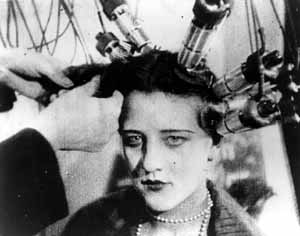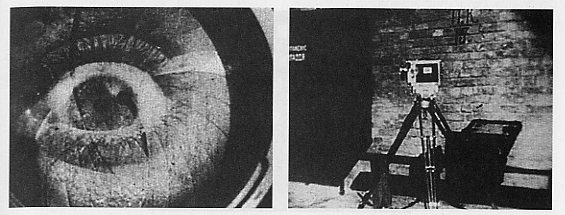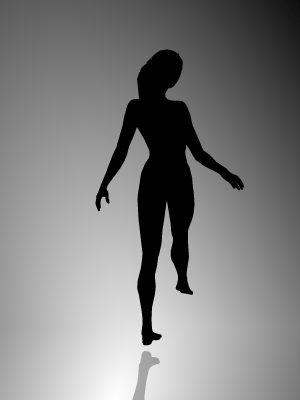This and all course sites are best viewed in a Firefox browser.

The illiterates of the future will be the people who know nothing of photography rather than those we are ignorant of the art of writing. —Laszlo Moholy-Nagy
|
 |
An essay, you will likely remember from your more traditional English classes, typically has a thesis (or at least a point—an arguable CLAIM about something); it is a genre of writing that often lets a writer explore a topic through research, reflection, and analysis, considering multiple points of view, and then arguing for one position.
A visual essay has those same characteristics, but instead of relying primarily on words to explore and argue, the “writer” now uses both words and images to make their argument.
I would like you to compose a visual essay that analyzes a film of your choice from one of the critical perspectives we've discussed: formalist, culturalist, or McCloud's triangle. The content of the essay should be traditional, which means (more or less): introduction, background, support and analysis, acknowledgement and refutation of counter-views, and conclusion. The form of the essay, though, will be nontraditional since of course you'll be using images.
The images you use can be:
- original pictures you take with a camera;
- pictures you find at home, on the internet, or elsewhere;
- images you touch up, draw on, write on, or otherwise "shop," fiddle with and improve.
- composed for the web;
- assembled in PowerPoint or other presentation software; or
- put together in some other imaginative way, as long as it is electronic.
Your essay should show complexity suitable for a 300-level writing course. It must have a clear and relevant thesis, as well as an identifiable critical method.
NOTE: It's extremely important that you do some research for this assignment. For example, if you are doing a formalist piece which focuses on acting or direction or production in a particular film, you MUST inform yourself about acting methods, the art and science of direction, or the business of production.
Note: you will need to be well-informed about the ways in which images and words can work together, so be sure to thoroughly read and view our Power Point presentation titled, Writing Your Visual Essay. It's also crucial that you do some research into your focus.
Audience
Your audience is me and your classmates—or any college instructor or student interested in film, art, visual culture, and the art of argument. Compose for an audience who tends to read broadly in many subjects, appreciates the off-beat, and is already somewhat knowledgable about graphic design. Imagine too that this audience is interested in fresh language and images; i.e., their aesthetic criteria are fairly demanding. This audience is additionally very interested in learning something about film and ways to view it. They are a skeptical bunch, though, and won't be convinced by an argument without lots of evidence and reasoning. And, because this audience reads a lot, they will be irritated by mechanical and stylistic flaws in your writing, so you'll need to edit well.
Purpose of Your Essay
Your task in this essay is to help your reader/viewer understand a particular film through a particular critical lens. You want to convince this reader that you interpretation of the film is valid, and you want your reader to have new insight into the film by the time they have finished your essay.
Purpose of Assignment
The purpose of this assignment is give you still further practice working with images and presentation software. It is also to give you further practice being a strong writer: knowing how to make an argument, paying attention to audience, analyzing a subject with clarity and complexity, finding and integrating meaningful research, creating compositions that are focused and developed, and gaining increasing skill as an editor and proofreader.
Supplemental Letter
Please include with your project a 1-2 page, typed and double-spaced informal letter to me explaining what you were attempting to accomplish in your essay, what kinds of word-image combinations you used (drawing on info in our Power Point presentations), how you drew on one of the three approaches to film we learned about, how you integrated elements of traditional argument into your essay, etc. This letter is meant to help me understand what you were aiming to produce (even if your piece doesn't fully reach its aims).
Our eyes see very little and very badly – so people dreamed up the microscope to let them see invisible phenomena; they invented the telescope…now they have perfected the cinecamera to penetrate more deeply into the visible world, to explore and record visual phenomena so that what is happening now, which will have to be taken account of in the future, is not forgotten.
—Provisional Instructions to Kino-Eye Groups, Dziga Vertov, 1926
Grading Rubric

Key Components of Your Essay |
Comments |
Essay makes a clear and arguable point about a film. |
|
| Essay develops and supports its central point with specific details, evidence, and clear reasoning, as well as vocabulary and frameworks discussed in course materials. The essay draws on logos, ethos, and pathos to make its case, and the reader/viewer is left feeling convinced by the end of the piece. |
|
Essay successfully applies one of the three critical approaches learned in our Power Point presentation, Reading Film. Formalist essays MUST discuss theme and examine in an informed way one or more specific formal element. Culturalist essays MUST at some point comment on ideology and include research for breathe and depth of analysis. All essays must use vocabulary introduced in course materials. |
|
Sources meaningful and significantly inform the essay. Formalist essays show research into the formal element or elements being discussed. Culturalist essays show research which lends complexity and scope. Sources are documented at the end of the essay or on a separate page, using MLA format. Note: a visual essay does not require extensive or detailed in-text citation (that would take away from the aesthetic appeal of the visual essay. |
|
|
|
| Project includes a well-written supplementary letter. | |
| The ratio of text to image is about 50-50. | |
| The medium should be effective, the technology workable and without glitches, and the execution of high quality. |
Tip
If you have technology questions, visit the Technology Learning Center in IACC 150.
"Kino-Eye": a term devised by early Russian film maker Dziga Vertov. Look it up!


 say
say